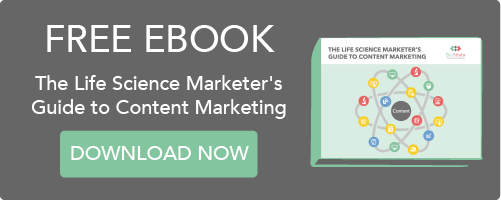With a keen focus on using inductive reasoning to understand processes of the natural world, the scientific method was a huge milestone for human development and helped us shed the unscientific mysticism of the dark ages. Flash forward to today, and its illuminative approach spans far beyond the laboratory. For instance, applying the scientific method to content marketing can lead to much better results.
Content marketing already has a keen focus on data, so it only makes sense to take a scientific approach to the development of your science content strategy and the selection of your tactics.
All you have to do is follow these steps:
Find the right question to ask
As Douglas Adams showed us in The Hitchhiker’s Guide to the Galaxy, asking the right question is often more important than finding its answer. It might be tempting to start off with a grandiose question like “How do I increase the profitability of my content marketing strategy?”, but vague questions will often get vague answers – “By doing it well.”
The trick is to break that broad objective down into smaller questions that you can actually measure and find a workable answer to. For example, “When targeting a certain persona, which of these two content formats is most effective?” Let’s say the persona in question is a researcher at a molecular genetics lab in Surrey, and you’re trying to determine whether they’ll respond better to an infographic or a Slideshare.
This question will obviously require a fair bit of preliminary research. Make sure the persona you’ve chosen is suitable for your company and a key decision maker in their own company’s chain of command.
Develop a hypothesis
Now’s the time to try and predict what the result of your experiment will be – do you think Researcher Ronald will prefer a colourful infographic or a detailed Slideshare? Developing a hypothesis will keep you on track and your research focused. It will also force you to think critically of the situation while you learn more about your target market and their buyer’s journey.
While you’re hypothesising, try and be cognisant of your own biases that might be skewing your approach to the problem. Assuming that a certain result is going to occur may influence your execution of the experiment and detract from its objective value. For more on this idea, check out our blog, “Content marketing and the theory-ladenness of observation”.
Conduct the experiment
Finally, it’s time to get your hands dirty. There are many ways to approach experimentation in content marketing, and it’s up to you to find the best method for your given question and situation. One of the most popular is A/B testing, which involves showing two different versions of a web page to similar visitors who fit your persona profile. With half the group seeing one and the other half seeing the other, you can then compare the conversion rates and declare a winning version. Just be sure to take note of all variables, such as geography, demographic and time of day, and account for the sample size.
In the context of our example, you could either go the A/B testing route, or you could post both content formats at the same time and see which has a better click rate. Another option is to find a test group of people who fit into your persona profile and outright ask them which content format they’d prefer in the form of a survey or questionnaire. Make sure to tweak the experiment as you go along so that you have a wider range of data and control for different variables – the more data you have, the more accurate your results will be. In the context of A/B testing, you could tweak the weaker version of the design to try and hone in on the specific features your targets find most appealing.
Analyse your results
Now that you have your raw data, it’s time to dive into its analysis. Even if there was a clear favourite, make sure you consider multiple interpretations of the data and account for all the variables. For example, let’s say that Researcher Ronald clicked through to the infographic more than the Slideshare. This fact alone is insufficient to make a conclusion without supporting evidence like their bounce rate or conversion rate. If the infographic is more visually appealing, but doesn’t engage the prospect to the extent that they stay on the site for longer than a few seconds, then you have a genuine, actionable insight. When analysing your data, always think about its implications for your content marketing strategy and how it can be improved going forward.
Build on your results with further research
The scientific method is a continuous process, fuelling perpetual experimentation, growth and improvement. As such, always be on the lookout for new ways to measure the efficacy of a given process or test the effectiveness of a certain content decision. You can always improve on a strategy, no matter how great it is performing – never stop tweaking, tinkering and experimenting.
For more on getting the most from content marketing in the life science sector, download our free eBook, “A Life Science Marketer's Guide to Content Marketing”.





